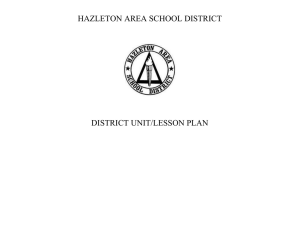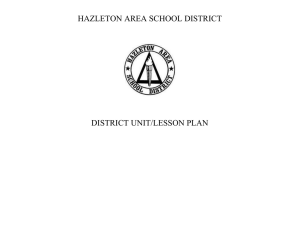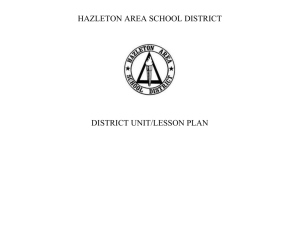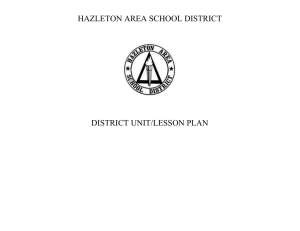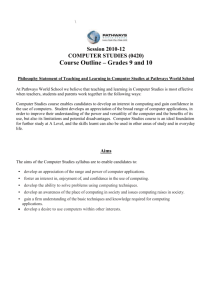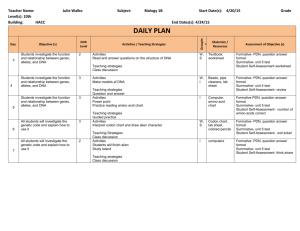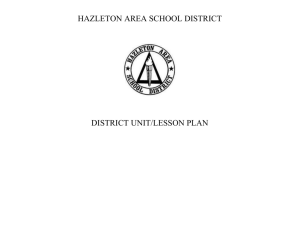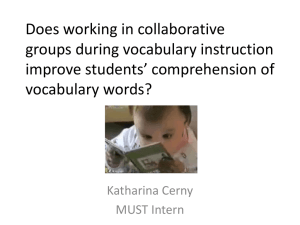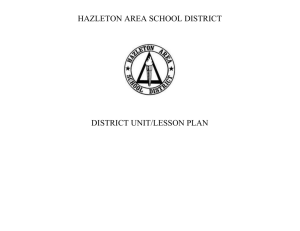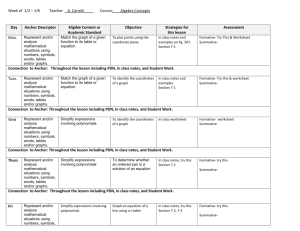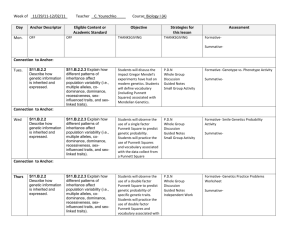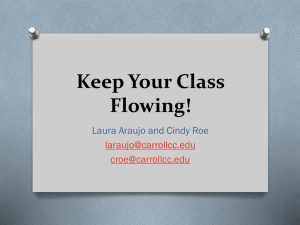Unit Plan - Hazleton Area School District
advertisement
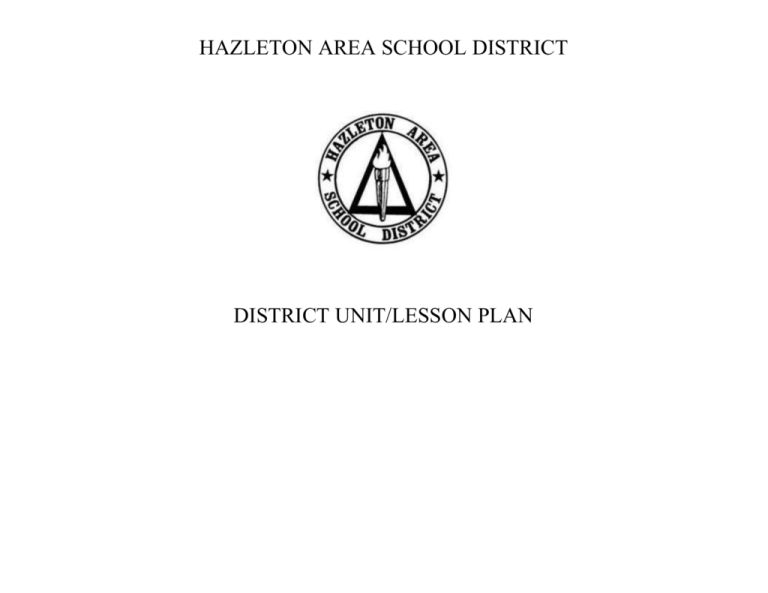
HAZLETON AREA SCHOOL DISTRICT DISTRICT UNIT/LESSON PLAN Teacher Name : Allyson Correale Subject : Reading Start Date(s): 10/20/14 Grade Level (s): 5th Building : West Hazleton Unit Plan Unit Title: an educational unit title summarizes content across several lessons that establishes and reinforces certain skills and essential knowledge for grade levels and content areas. On Second Thought Essential Questions: Essential questions are concept in the form of questions. Questions suggest inquiry. Essential questions are organizers and set the focus for the lesson or unit. Essential questions are initiators of creative and critical thinking. Essential questions are conceptual commitments focusing on key concepts implicit in the curriculum How can experiencing nature change the way you think about it? Standards: PA Core Standards, PA Academic Standards/Anchors (based on subject) E05. B-K.1.1- Demonstrate understanding of key ideas and details in informational texts. E05.B-C.2.1 – Demonstrate understanding of craft and structure in informational texts. E05.B-C.3.1 – Demonstrate understanding of connections within, between, and among informational texts. E05.B-V.4.1 – Demonstrate understanding of vocabulary and figurative language in informational texts. E05.C.1.3- Write narratives to develop real or imagined experiences or events using effective technique, descriptive details, and clear event sequences. E05.D.1.1- Demonstrate command of the conventions of standard English grammar and usage Summative Unit Assessment : Summative Assessment Objective Students will identify and use story vocabulary within the context of sentences and paragraphs. Students will read, analyze, and discuss two different Narrative Nonfiction stories. Students will reread and close read the stories using text evidence to respond to questions and prompts relating to these stories. Students will read and analyze a short autobiography on Theodore Roosevelt and make connections/comparisons to the Narrative Nonfiction stories.. Students will identify cause and effect in different stories and create cause and effect charts. Students will identify different Assessment Method (check one) _ x__ Rubric ___ Checklist __x__ Unit Test ____ Group ____ Student Self-Assessment ____ Other (explain) characteristics of Narrative Nonfiction and identify examples from the stories being read. Students will identify homographs and use them correctly within sentences and paragraphs. Students will use descriptive details and proper grammar to write an autobiography of their own. Day 1 Objective (s) Students will listen to a Read Aloud to build background knowledge. Students will identify the meaning of and use story vocabulary correctly within the context of sentences and paragraphs. DOK LEVEL 1,2 Activities / Teaching Strategies Structured overview Cooperative learning Discussion Grouping DAILY PLAN W,S Materials / Resources Reading/Writing Workshop Books Vocabulary Cards Your Turn Book Assessment of Objective (s) Formative- Discussion Exit Pass Summative- Completion of LAB book page 21 Student Self - AssessmentCollaborative discussions 2 3 4 Students will read, analyze, and discuss the narrative nonfiction story, “A Life in the Woods”, as a whole group. Students will write a journal entry about a time they encountered nature. 1,2,3 Students will discuss the reading strategies: Ask and Answer Questions and Cause and Effect. Students will reread and close read the story to complete a cause and effect chart using information from the story. 1,2,3 Students will identify different aspects of Narrative Nonfiction and use text evidence from the story, “A Life in the Woods”. Students will identify and use Homographs correctly within the 2,3,4 Guided and Shared Cooperative discussions Journal Writing W,I Reading/Writing Workshop Books Journals Formative- Collaborative discussion Summative- Journal entry Student Self - AssessmentQuestioning Guided and Shared Reading for meaning Peer partner learning W,S Reading/Writing Workshop Books Your Turn Book Student-created Cause and Effect charts Formative- Collaborative discussion Summative- Completion of Your Turn book pages 23-25 Cause and Effect charts Student Self - AssessmentDiscussion Questioning Reading for meaning Think-pair-share Collaborative discussions W,S Reading/Writing Workshop Books Your Turn Book Formative- Collaborative discussion Exit pass Summative- Completion of Your Turn book pages 26 and 27 context of sentences. Student Self - AssessmentQuestioning Students will close read the story, “Camping with the President”, and create a cause and effect chart using text evidence. 2,3,4 Reading for meaning Think-pair-share Collaborative discussions W,S Literature Anthology Student created cause and effect charts Formative- Think-pair-share Exit pass Summative- Completed cause and effect chart 5 Student Self - AssessmentReflective response 6 7 Students will read, analyze, and discuss, the autobiography, “A Walk with Teddy”, in their cooperative groups. Students will begin composing an autobiography of their own. Students will complete the vocabulary quiz. 1,2,3,4 Students will finish their first draft of their autobiographies, peer edit each other’s autobiographies, and complete a final copy. 2,3,4 Think-pair-share Collaborative discussions Essays W,I Literature Anthology Student written autobiographies Quiz Formative- Think-pair-share Exit pass Summative- Vocab Quiz Student Self - AssessmentQuestioning Essays W,I Student written autobiographies Formative- Exit pass Summative- Final copy of autobiography Student Self - AssessmentQuestioning 8 Students will complete the selection test, “Camping with the President”. 1,2,3 Reading for meaning I Selection Test Formative- Exit pass Summative- Completion of test Student Self - AssessmentQuestioning 9 Students will complete the Weekly Assessment Test by using context clues, text evidence, homographs, and identifying cause and effect 1,2,3 Reading for meaning I Weekly Assessment Test Formative- Exit pass Summative- Completion of test Student Self - AssessmentQuestioning Students will read, analyze, and discuss one of the Leveled Reader stories in collaborative groups. 10 2,3,4 Reading for meaning Collaborative discussions S Leveled Readers Formative- Think-pair-share Exit pass Summative- Student Self - AssessmentQuestioning Discussion
